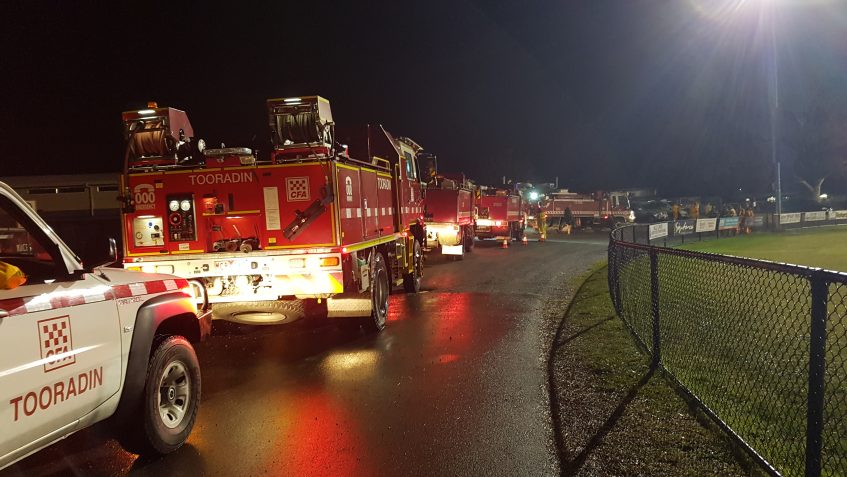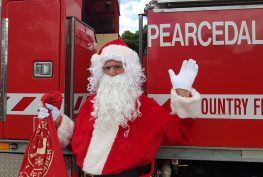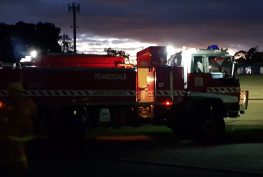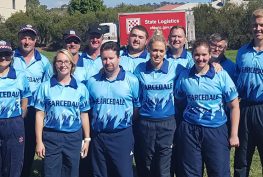 On Monday 24th April, Pearcedale Fire Brigade hosted a training exercise with neighbouring brigades from Casey and Westernport groups. Approximately 90 Volunteers from Tooradin Fire Brigade, Devon Meadows Fire Brigade, Warneet-Blind Bight Fire Brigade, Baxter Fire Brigade, Clyde Fire Brigade, Skye Fire Brigade, Somerville Fire Brigade and Tyabb Fire Brigade got together at the local Pearcedale Football ground for a simulated training exercise.
On Monday 24th April, Pearcedale Fire Brigade hosted a training exercise with neighbouring brigades from Casey and Westernport groups. Approximately 90 Volunteers from Tooradin Fire Brigade, Devon Meadows Fire Brigade, Warneet-Blind Bight Fire Brigade, Baxter Fire Brigade, Clyde Fire Brigade, Skye Fire Brigade, Somerville Fire Brigade and Tyabb Fire Brigade got together at the local Pearcedale Football ground for a simulated training exercise.
As this was to be a large exercise, the surrounding streets had been notified of the event by way of Facebook posts and a letterbox drop. The residents were very supportive and many came out to watch as things unfolded.
 With 19 appliances participating, we had Somerville Support providing the Staging Area Management, and Westernport Group provided the FOV (Forward Operational Vehicle) to assist with communications and to act as our VicFire Dispatch channel. The Casey Group FCV (Forward Control Vehicle) was used as an Operations Point throughout the exercise. Our local paramedics, Carmel and Kevin kindly provided us with the Ambulance at the Staging Area.
With 19 appliances participating, we had Somerville Support providing the Staging Area Management, and Westernport Group provided the FOV (Forward Operational Vehicle) to assist with communications and to act as our VicFire Dispatch channel. The Casey Group FCV (Forward Control Vehicle) was used as an Operations Point throughout the exercise. Our local paramedics, Carmel and Kevin kindly provided us with the Ambulance at the Staging Area.
At approximately 7:15pm, the members of Pearcedale Fire Brigade were paged to the training scenario and advised of an “undefined fire” at Nathaniel Street. The street runs adjacent to a reserve known as the Colley Street Bushland Reserve. With simulated weather conditions and a spreading fire, Incident Controller Captain Alistair Errey called to “make tankers 10 and Ultralights 3”. The tankers were quickly dispatched from the Staging Area to the Colley Street Reserve and put to work getting water on to the fire and utilising the hydrants throughout the street.
 Crews continued to attack the fire at the reserve as well as provide asset protection to the adjoining houses. Ultralights were directed to attend to spot fires in a nearby paddock. In-field support was also dispatched to the scene, with two Strike Team Leaders and a Sector Commander rounding up and managing the appliances. The Control Point was set up in a nearby parking lot allowing the Incident Controller and Operations to oversee and direct operations from a central location utilising the multiple radios and other facilities available on the Casey FCV. With fireground channels established, the FOV continued to monitor radio traffic and play the part of VicFire Dispatch.
Crews continued to attack the fire at the reserve as well as provide asset protection to the adjoining houses. Ultralights were directed to attend to spot fires in a nearby paddock. In-field support was also dispatched to the scene, with two Strike Team Leaders and a Sector Commander rounding up and managing the appliances. The Control Point was set up in a nearby parking lot allowing the Incident Controller and Operations to oversee and direct operations from a central location utilising the multiple radios and other facilities available on the Casey FCV. With fireground channels established, the FOV continued to monitor radio traffic and play the part of VicFire Dispatch.
As part of the scenario, a firefighter sustained an ankle injury which required patient transport from the paddocks to the paramedics where he made a full (and remarkably quick) recovery. The simulated fires were brought under control quickly with no residential damage or injuries.
The training exercise helped to identify areas for improvement at escalating incidents within the district and provided a measure of how well the incident could be managed in the real world. One of the key identifiers was to determine how the mains water supply would cope with multiple appliances boosting in the one street. For those technically inclined, the pressure dropped from 550Kpa to around 150Kpa with 6 appliances boosting at once.
The simulation was also a good test of using the Casey Group’s “go forward” pre-plans and having them put into action. The initial call for “make tankers 10” automatically triggers the In Field response of pre-determined Strike Team Leaders, pencillers and drivers. Being able to form oncoming appliances into Strike Teams in the early stages of an incident makes operations a lot more manageable.
Feedback from crews has been extremely positive with everyone having a great evening learning or reinforcing fireground roles. A special thanks to our Training Officer, Chris Judd, for organising the evening and putting in such a huge amount of work to make it happen.
(Story and photos by Robyn Murphy)















Comments
No Comments